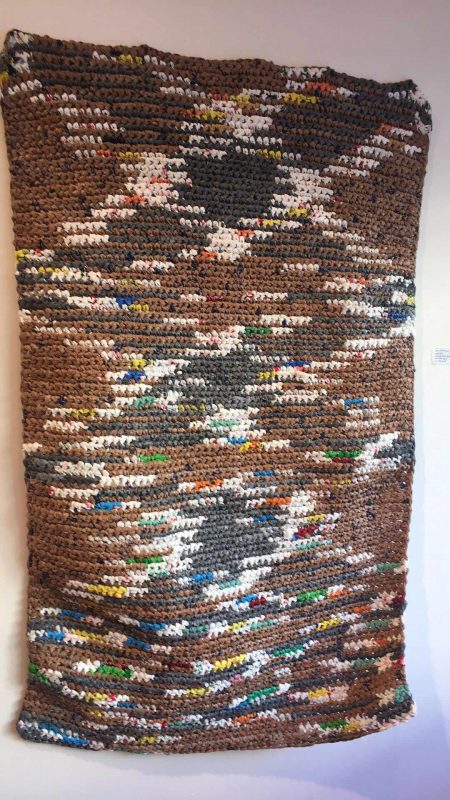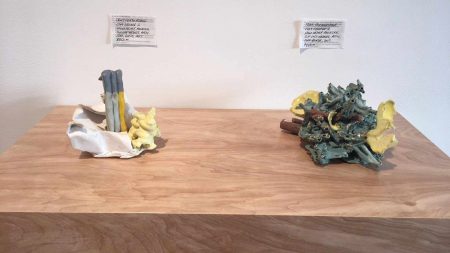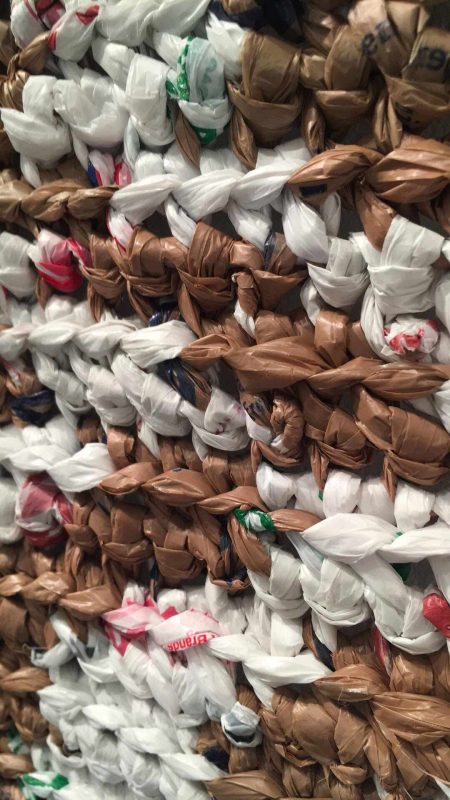Social workers Keith Banner and Bill Ross created Visionaries + Voices for the artists Paul Rowland, Richard Brown, Antonio Adams, and Raymond Thunder-Sky. Bill and Keith arduously worked for county boards serving individuals with disabilities and had met these artists in the course of their work. Subsequently, the pair created more opportunities for artists to organize shows and to present the work of artists with disabilities. By 2003, Visionaries + Voices had become a full 501(c)3 non-profit organization and were serving up to 30 artists per week including founding artists Antonio Adams and Raymond Thunder-Sky. The gallery pays homage to subaltern groups, as evinced in “Pre-Existing Conditions” featuring work from artists who explore the value and mystery of found and un-found materials. The artists included in the show are Blake Clark, Amy Castellino, Tracy Featherstone, and Dion Hitchins. Some of these artists are “outsider artists,” which mirrors the Thundersky ethos. The show’s reception was on April 14, 2018 and closes on June 1, 2018.
These four artists come from a diverse background stylistically – some installation artists, other appropriation artists, and others who work in the drawing/painting media. As a result, the diverse styles that are exhibited are varied and multifaceted. For example, nineteen year old Blake Clark is a Northern Kentucky native who uses product packaging and psychedelic drawing-laden shopping bags to construct multi-paneled work in “Gut Buddies.” The piece displays several monstrous, amorphous figures whose organs weave in and out of their figuration. Interestingly, Clark has printed these fantastical beings on disposable paper bags, demarcating their inherent utility and disposability. Pacson and Nike logos provide for the foreground in these images that depict ferocious monstrosities and alien figures. Blake Clark draws inspiration from rock and roll psychedelic, with images redolent of Gerald Potterton’s feverish animated sci-fi fantasy film.
Dion Hitchings is a New Jersey artist whose work finds influence from wrappers and deconstructed debris, facilitating portraits that frame “throwaway culture”. During a 2016 interview with NZ Sculpture Onshore, Dion stated that he creates contemporary art experiences that share a lineage of thought that is informed from New Zealand Maori and Buddhist philosophy. Such ideas investigate the phenomenological interconnectedness of all things. Hitchins’ intent is that, through his art experiences, he inspires growth, sharing and stronger connections to the environment, organizations, and to one another. The psychedelic properties in Hitchins’ work, inspired by Native cultures, culls the remnants of complex neural and cultural networks in their repeated, complex, and appropriated forms to suggest cross-word puzzles. Hitchins recently completed work with Fonterra, assisting the alignment of company values to cultural stories, through the creation of touch-stone foyers. His work can be found in major collections around the country including Te Papa, Waikato Museum and Auckland City Art Gallery. He also has public works with Auckland and Hamilton City Council. He is interested in how the values from the past can inform our actions for the future. He is of Tuhoe, Ngati Porou, (New Zealand Maori), Chinese, English and Scottish descent – Hitchins is a global citizen with a tribal view.
As a sculptor of Maori and Chinese heritage, Dion is known for his culturally inspired works. This piece was influenced by the pantheon of 140 Maori Gods and in particular the untold stories of the Missing Maori Goddesses. Hitchens once stated that “Our written history has been recorded by men, which in turn has influenced our culture and values through recent generations. This is highlighted in the storytelling of the Maori Gods, where the female Goddesses are only mentioned in relation to the male Gods; the female knowledge was not shared as the anthropologists only consulted men.” By undoing the divide between male and female energies, as in “Yin and Yang” or “1 and 0,” Hitchens explores the balance between universality and internal self (Scoop). Recently, NZ Sculpture OnShore selected Hitchens’ work as part of its 2016 exhibition to be showcased on 10-20 November at Fort Takapuna, Devonport. The exhibition is the largest and longest running outdoor sculpture show in New Zealand.
Amy Castelino, born in India, is an outsider artist who seeks to repurpose grocery bags into blankets for homeless people. Castelino responds to her environment by fashioning mats and pillows that she never sells, preferring to give them to homeless people in need. Castelino’s work, which poetically mirrors prayer rugs, fits within the genealogy of public and instrumentalizable activist performance, such as Michael Rakowitz’ controversial 1997 project “parasite: homeless shelter.” Rather than functioning as art-objects, Castelino’s work is not an art-object but located in true functionality. Like a parasite, this temporary and transportable shelter for the homeless is dependent on a host. In this case, the host is an outtake duct of a building’s HVAC (heating, ventilation, and air-conditioning) system. In 1997 Rakowitz proposed a prototype of this shelter to a homeless man named Bill Stone in Cambridge, Massachusetts. At the time, Cambridge officials had installed tilted grates over air vents in Harvard Square to prevent homeless people from sleeping on them. Rakowitz created the first paraSITE homeless shelter from discarded materials, including Ziploc bags and packing tape. Now, the “igloo-like” sculptures are made of polyethylene, another found and unfound material. Castelino custom-made dozens of similar shelters to be used in several East Coast cities and asked for a mere five dollar production cost in order to make the functional pieces free of charge.
Notably, the term “pre-existing conditions,” is used within the health-care semblance, wherein medical conditions necessitate how insurance plans can reject one, charge them more, or refuse to pay people for essential health benefits prior to starting their coverage (healthcare.org). Keith and Bill chose the title “Pre-Existing Condition” to denote that a terms used by health insurance companies and the government in denying accessable and affordable healthcare in America. Hence, the show is galvanized by an activist ethos that seeks to bring subjectivity and human qualia within the rigid sphere(s) of medical practice and sociology. Art objects with a sociologically-galvanized ethos equip “Pre-existing Conditions.” The show subverts rigid and deterministic lines by offering re-envisioned meaning-making to motivate bypractices and repurposed materials within the schema of art-production.
Tracey Featherstone ‘s work explores the notion of landscape and interactive sculpture, inspired by Asian cultures. Her recent series “Wearable Structures” provides for a series of artistic wooden sculptures that interact with the body as “geometric fungi,” exploring the human struggle of disability, control, and chaos as Featherstone attempts to mediate a balance. Featherstone uses traditional building materials in order to create micro-environmental structures that attach bodies to movement and control, imposing order on situations that are “moving out of control” (Derringer). Featherstone’s dribbling clay collages, titled “Clay Collage 2,” are produced by an amalgamation of found and recycled objects, that indexically cull their material processes and formations. Featherstone’s pedestal piece “Mohawk Montra” was inspired by found objects that she has transformed into bodily, disfigured, and amorphous figures. “Mohawk Montra” shows a basket that refers to a shrine that is used in India where people tie droppings to it so that vegetation burgeons – an index to growth, environment, and life-cycle. Featherstone’s sculptures are disintegrated in a post-firing process, showing the materials from which they have been constructed. Featherstone’s “Origin” is a floral sculpture that continues to grow beyond “Pre-Existing Conditions” as it burgeons and grows, noting how elementary nature is dichotomous to sterile sculpture, painting, or staid print media.
“I’m a social worker so the whole notion of pre-existing condition would eliminate everyone I worked with up to Healthcare” states Bill, the co-founder of Thundersky (alongside his partner Keith) who works with Hamilton County. For this show, Bill has targeted the contemporary sociopolitical zeitgesit by inviting humanity re: pastiche and utility-based transformations, undoing the traditional rarified gallery walls. The show is symbiotic in its activist ethos and, despite “Pre-Existing Conditions” does not escape the bounds of the gallery space. It targets various political issues, encouraging dialogue on homelessness, poverty, product-packaging, environmentalism, and disposability. Incredibly apt, Pre-Existing Conditions’ piece titles motivate recycling, reuse, and utility as they are all scribbled on lost receipts.
–Ekin Erkan





